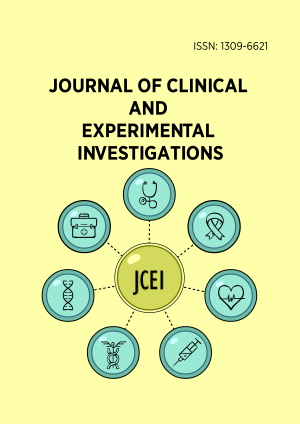Volume 5, Issue 3, September 2014
Research Article
Prevalence of thyroid disorders and the correlation of thyroid profile with liver enzymes, serum activin-A and follistatin during the treatment of patients with chronic hepatitis C genotype 1 and 4
J Clin Exp Invest, Volume 5, Issue 3, September 2014, 343-353
https://doi.org/10.5799/ahinjs.01.2014.03.0418Research Article
The roles of urine interleukin-13, CD80, CD28, matrix metalloproteinase-2 and granzyme B in the pathogenesis of childhood minimal change nephrotic syndrome
J Clin Exp Invest, Volume 5, Issue 3, September 2014, 354-361
https://doi.org/10.5799/ahinjs.01.2014.03.0419Research Article
Evaluation of the analytical performance of Roche immunoturbidimetric immunoglobulin assays and comparing to Dade Behring immunonephelometer
J Clin Exp Invest, Volume 5, Issue 3, September 2014, 362-367
https://doi.org/10.5799/ahinjs.01.2014.03.0420Research Article
Anatomy-Based navigation for ventriculostomy: Nasion-coronal suture distance measurement
J Clin Exp Invest, Volume 5, Issue 3, September 2014, 368-370
https://doi.org/10.5799/ahinjs.01.2014.03.0421Research Article
Comparison of two different methods for the determination of erythrocyte sedimentation rate
J Clin Exp Invest, Volume 5, Issue 3, September 2014, 371-375
https://doi.org/10.5799/ahinjs.01.2014.03.0422Research Article
Evaluation of serum cortisol and dehydroepiandrosterone sulphate levels in parkinson patients with and without postural instability
J Clin Exp Invest, Volume 5, Issue 3, September 2014, 376-380
https://doi.org/10.5799/ahinjs.01.2014.03.0423Research Article
The diagnostic value of mean platelet volume in males with premature atherosclerotic coronary artery disease having stable angina pectoris
J Clin Exp Invest, Volume 5, Issue 3, September 2014, 381-385
https://doi.org/10.5799/ahinjs.01.2014.03.0424Research Article
The knowledge level of chest physicians about the pulmonary rehabilitation topic
J Clin Exp Invest, Volume 5, Issue 3, September 2014, 386-390
https://doi.org/10.5799/ahinjs.01.2014.03.0425Research Article
Nonfermentative gram-negative microorganisms isolated from intensive care units and their resistance profiles in a training and research hospital
J Clin Exp Invest, Volume 5, Issue 3, September 2014, 391-396
https://doi.org/10.5799/ahinjs.01.2014.03.0426Research Article
The effects of 10 cmH 2 O positive end-expiratory pressure on arterial oxygenation, respiratory mechanics and hemodynamic parameters in laparoscopic cholecystectomy operations
J Clin Exp Invest, Volume 5, Issue 3, September 2014, 397-402
https://doi.org/10.5799/ahinjs.01.2014.03.0427Research Article
The outcome of conservative treatment of adult distal radius fractures compared with the other wrist: radiological and functional evaluation
J Clin Exp Invest, Volume 5, Issue 3, September 2014, 403-409
https://doi.org/10.5799/ahinjs.01.2014.03.0428Research Article
Effects of various factors on bacteria colonization at the mobile phones and on the hands of medical faculty students
J Clin Exp Invest, Volume 5, Issue 3, September 2014, 410-414
https://doi.org/10.5799/ahinjs.01.2014.03.0429Research Article
Effect of erythropoietin use on mean platelet volume in children undergoing chronic dialysis
J Clin Exp Invest, Volume 5, Issue 3, September 2014, 415-419
https://doi.org/10.5799/ahinjs.01.2014.03.0430Research Article
The evaluation of rubella and sitomegalovirus IgG avidity tests in pregnants: four-year experience
J Clin Exp Invest, Volume 5, Issue 3, September 2014, 420-423
https://doi.org/10.5799/ahinjs.01.2014.03.0431Research Article
Evaluation of dynamic hyperinflation and exercise capacity in patients with COPD
J Clin Exp Invest, Volume 5, Issue 3, September 2014, 424-428
https://doi.org/10.5799/ahinjs.01.2014.03.0432Research Article
The assessment of knowledge level about their disease in patients with rheumatoid arthritis
J Clin Exp Invest, Volume 5, Issue 3, September 2014, 429-434
https://doi.org/10.5799/ahinjs.01.2014.03.0433Research Article
The predictors of atrial fibrillation in patients with rheumatic mitral stenosis
J Clin Exp Invest, Volume 5, Issue 3, September 2014, 435-440
https://doi.org/10.5799/ahinjs.01.2014.03.0434Case Report
Chondroid Syringoma: A case with unusual localization
J Clin Exp Invest, Volume 5, Issue 3, September 2014, 441-443
https://doi.org/10.5799/ahinjs.01.2014.03.0435Case Report
Cytogenetic and clinic evaluation of two cases that have 45,X/46,X,i(Xq) and 46,X,i(Xq) karyotype
J Clin Exp Invest, Volume 5, Issue 3, September 2014, 444-448
https://doi.org/10.5799/ahinjs.01.2014.03.0436Case Report
Atropine-induced non-sustained polymorphic ventricular tachycardia: A rare case
J Clin Exp Invest, Volume 5, Issue 3, September 2014, 449-451
https://doi.org/10.5799/ahinjs.01.2014.03.0437Case Report
A rare and dangerous infectious lesion: Hydatid disease of the cervical spine
J Clin Exp Invest, Volume 5, Issue 3, September 2014, 452-455
https://doi.org/10.5799/ahinjs.01.2014.03.0438Case Report
Bilateral exotropia following pterygium surgery: Case report
J Clin Exp Invest, Volume 5, Issue 3, September 2014, 456-458
https://doi.org/10.5799/ahinjs.01.2014.03.0439Case Report
Anesthetic management of a case with adrenoleukodistrophy and mitochondrial myopathy
J Clin Exp Invest, Volume 5, Issue 3, September 2014, 459-461
https://doi.org/10.5799/ahinjs.01.2014.03.0440Case Report
Mass mimicking tuberculosis cases diagnosed postoperatively
J Clin Exp Invest, Volume 5, Issue 3, September 2014, 462-465
https://doi.org/10.5799/ahinjs.01.2014.03.0441Case Report
Multiple drugs poisoning resulting in ARDS
J Clin Exp Invest, Volume 5, Issue 3, September 2014, 466-468
https://doi.org/10.5799/ahinjs.01.2014.03.0442Case Report
A case of pneumothorax due to non-invasive mechanical ventilation
J Clin Exp Invest, Volume 5, Issue 3, September 2014, 469-471
https://doi.org/10.5799/ahinjs.01.2014.03.0443Case Report
Can femoral dialysis catheter insertion cause a life threatening complication?
J Clin Exp Invest, Volume 5, Issue 3, September 2014, 472-474
https://doi.org/10.5799/ahinjs.01.2014.03.0444Review
Giant cell tumor of bone: current review of morphological, clinical, radiological, and therapeutic characteristics
J Clin Exp Invest, Volume 5, Issue 3, September 2014, 475-485
https://doi.org/10.5799/ahinjs.01.2014.03.0445Review
Human embryonic stem cells and microenvironment
J Clin Exp Invest, Volume 5, Issue 3, September 2014, 486-495
https://doi.org/10.5799/ahinjs.01.2014.03.0446Review
Current approaches for informed consent in pediatrics
J Clin Exp Invest, Volume 5, Issue 3, September 2014, 496-503
https://doi.org/10.5799/ahinjs.01.2014.03.0447Review
Cardiopulmonary exercise testing
J Clin Exp Invest, Volume 5, Issue 3, September 2014, 504-509
https://doi.org/10.5799/ahinjs.01.2014.03.0448
